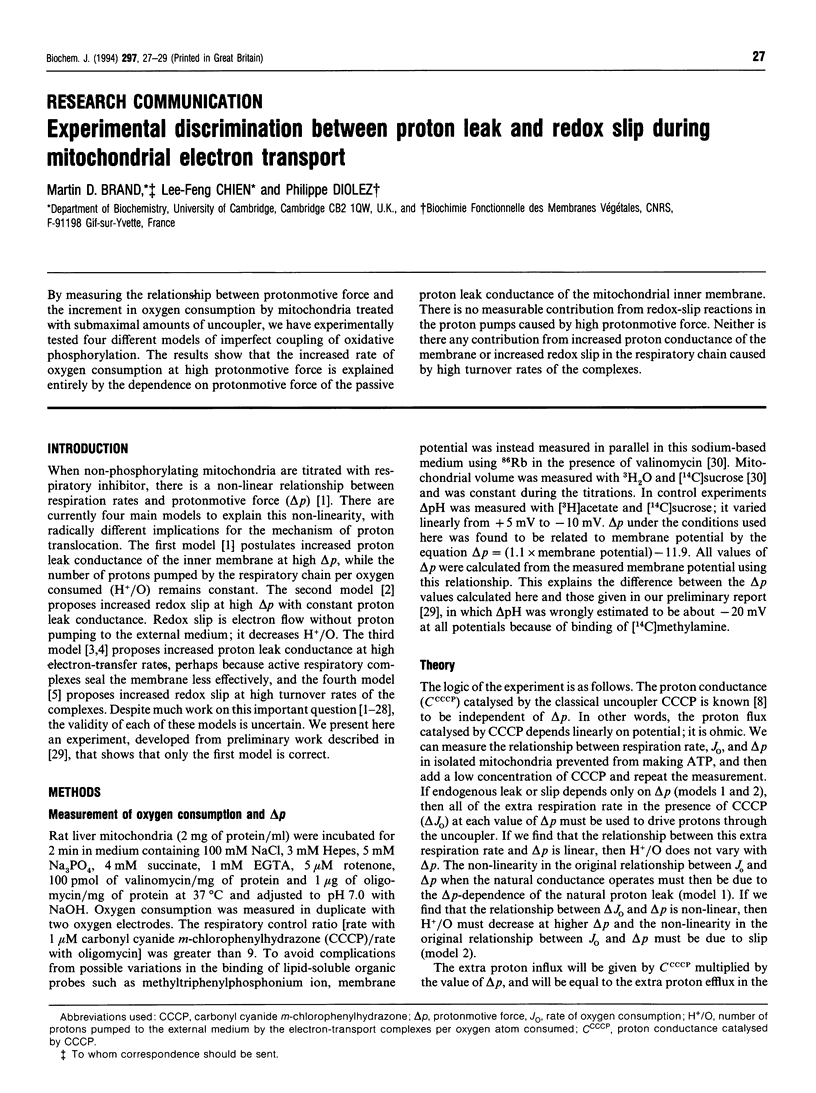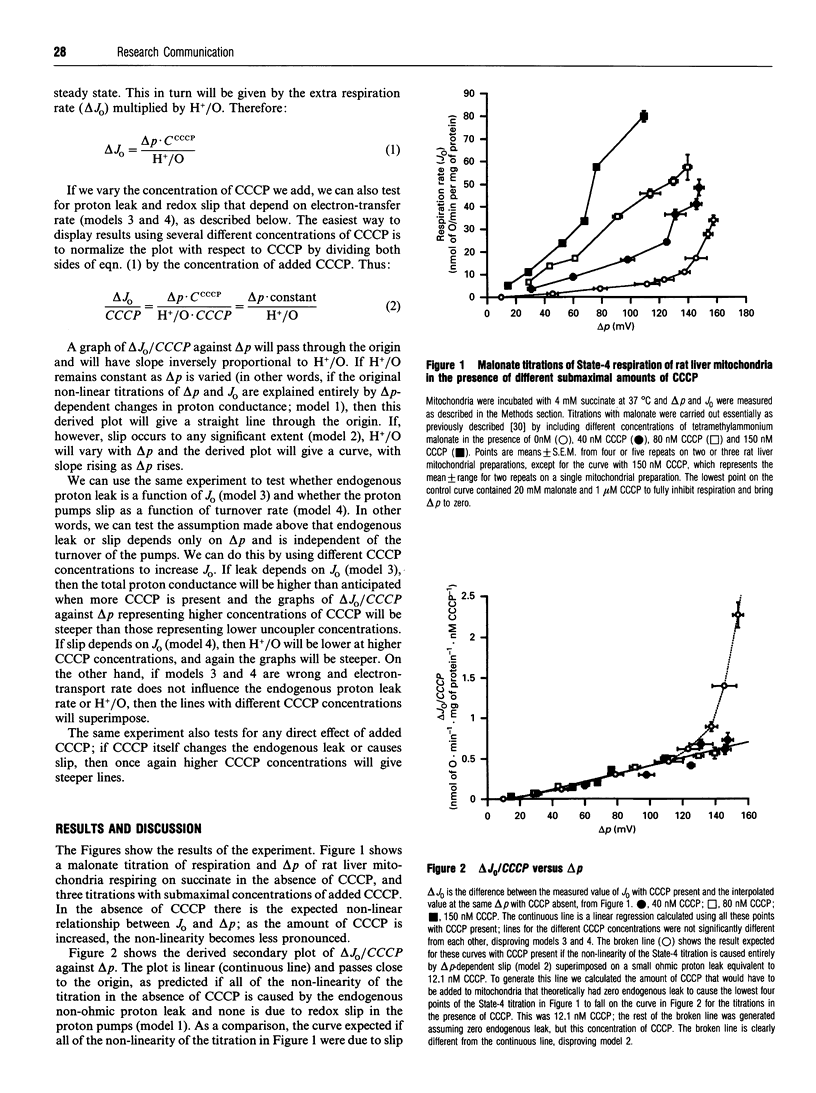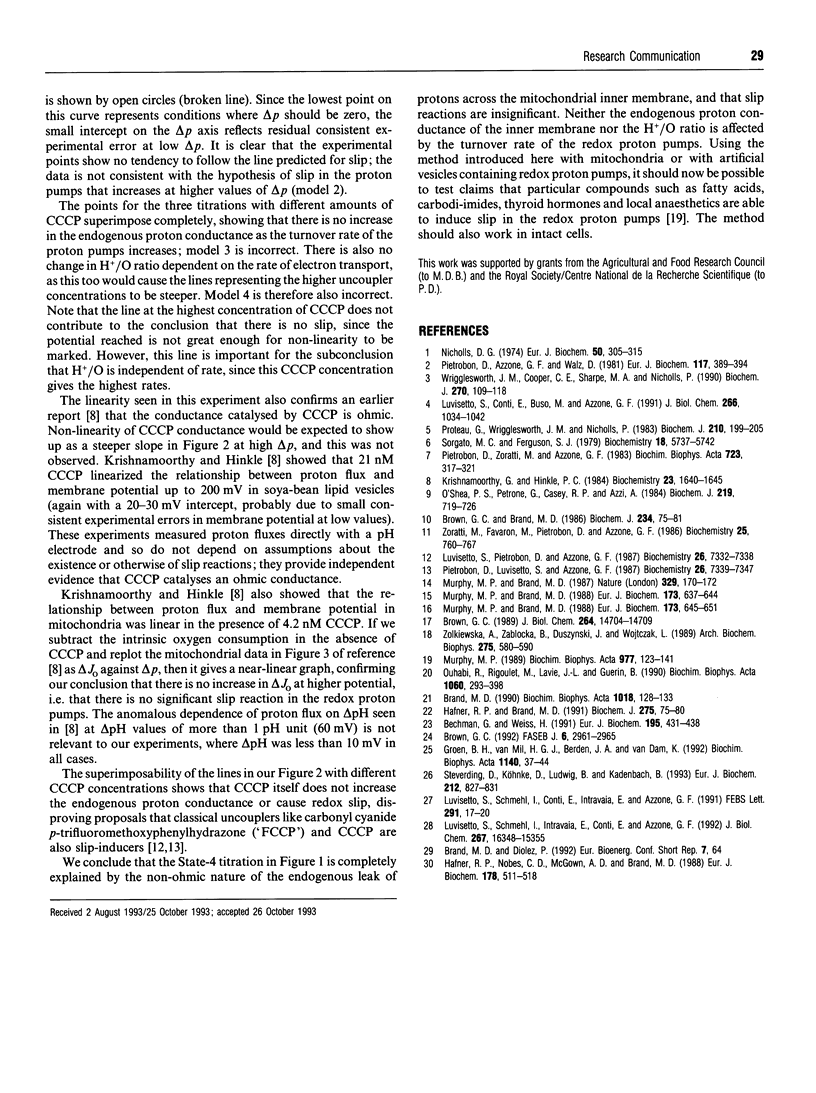Abstract
By measuring the relationship between protonmotive force and the increment in oxygen consumption by mitochondria treated with submaximal amounts of uncoupler, we have experimentally tested four different models of imperfect coupling of oxidative phosphorylation. The results show that the increased rate of oxygen consumption at high protonmotive force is explained entirely by the dependence on protonmotive force of the passive proton leak conductance of the mitochondrial inner membrane. There is no measurable contribution from redox-slip reactions in the proton pumps caused by high protonmotive force. Neither is there any contribution from increased proton conductance of the membrane or increased redox slip in the respiratory chain caused by high turnover rates of the complexes.
Full text
PDF


Selected References
These references are in PubMed. This may not be the complete list of references from this article.
- Bechmann G., Weiss H. Regulation of the proton/electron stoichiometry of mitochondrial ubiquinol:cytochrome c reductase by the membrane potential. Eur J Biochem. 1991 Jan 30;195(2):431–438. doi: 10.1111/j.1432-1033.1991.tb15722.x. [DOI] [PubMed] [Google Scholar]
- Brand M. D. The proton leak across the mitochondrial inner membrane. Biochim Biophys Acta. 1990 Jul 25;1018(2-3):128–133. doi: 10.1016/0005-2728(90)90232-s. [DOI] [PubMed] [Google Scholar]
- Brown G. C., Brand M. D. Changes in permeability to protons and other cations at high proton motive force in rat liver mitochondria. Biochem J. 1986 Feb 15;234(1):75–81. doi: 10.1042/bj2340075. [DOI] [PMC free article] [PubMed] [Google Scholar]
- Brown G. C. The leaks and slips of bioenergetic membranes. FASEB J. 1992 Aug;6(11):2961–2965. doi: 10.1096/fasebj.6.11.1644259. [DOI] [PubMed] [Google Scholar]
- Brown G. C. The relative proton stoichiometries of the mitochondrial proton pumps are independent of the proton motive force. J Biol Chem. 1989 Sep 5;264(25):14704–14709. [PubMed] [Google Scholar]
- Hafner R. P., Brand M. D. Effect of protonmotive force on the relative proton stoichiometries of the mitochondrial proton pumps. Biochem J. 1991 Apr 1;275(Pt 1):75–80. doi: 10.1042/bj2750075. [DOI] [PMC free article] [PubMed] [Google Scholar]
- Hafner R. P., Nobes C. D., McGown A. D., Brand M. D. Altered relationship between protonmotive force and respiration rate in non-phosphorylating liver mitochondria isolated from rats of different thyroid hormone status. Eur J Biochem. 1988 Dec 15;178(2):511–518. doi: 10.1111/j.1432-1033.1988.tb14477.x. [DOI] [PubMed] [Google Scholar]
- Krishnamoorthy G., Hinkle P. C. Non-ohmic proton conductance of mitochondria and liposomes. Biochemistry. 1984 Apr 10;23(8):1640–1645. doi: 10.1021/bi00303a009. [DOI] [PubMed] [Google Scholar]
- Luvisetto S., Conti E., Buso M., Azzone G. F. Flux ratios and pump stoichiometries at sites II and III in liver mitochondria. Effect of slips and leaks. J Biol Chem. 1991 Jan 15;266(2):1034–1042. [PubMed] [Google Scholar]
- Luvisetto S., Pietrobon D., Azzone G. F. Uncoupling of oxidative phosphorylation. 1. Protonophoric effects account only partially for uncoupling. Biochemistry. 1987 Nov 17;26(23):7332–7338. doi: 10.1021/bi00397a021. [DOI] [PubMed] [Google Scholar]
- Luvisetto S., Schmehl I., Conti E., Intravaia E., Azzone G. F. Activation of respiration and loss of thermodynamic control in hyperthyroidism. Is it due to increased slipping in mitochondrial proton pumps? FEBS Lett. 1991 Oct 7;291(1):17–20. doi: 10.1016/0014-5793(91)81093-n. [DOI] [PubMed] [Google Scholar]
- Luvisetto S., Schmehl I., Intravaia E., Conti E., Azzone G. F. Mechanism of loss of thermodynamic control in mitochondria due to hyperthyroidism and temperature. J Biol Chem. 1992 Aug 5;267(22):15348–15355. [PubMed] [Google Scholar]
- Murphy M. P., Brand M. D. Membrane-potential-dependent changes in the stoichiometry of charge translocation by the mitochondrial electron transport chain. Eur J Biochem. 1988 May 2;173(3):637–644. doi: 10.1111/j.1432-1033.1988.tb14046.x. [DOI] [PubMed] [Google Scholar]
- Murphy M. P., Brand M. D. The stoichiometry of charge translocation by cytochrome oxidase and the cytochrome bc1 complex of mitochondria at high membrane potential. Eur J Biochem. 1988 May 2;173(3):645–651. doi: 10.1111/j.1432-1033.1988.tb14047.x. [DOI] [PubMed] [Google Scholar]
- Murphy M. P., Brand M. D. Variable stoichiometry of proton pumping by the mitochondrial respiratory chain. Nature. 1987 Sep 10;329(6135):170–172. doi: 10.1038/329170a0. [DOI] [PubMed] [Google Scholar]
- Murphy M. P. Slip and leak in mitochondrial oxidative phosphorylation. Biochim Biophys Acta. 1989 Nov 23;977(2):123–141. doi: 10.1016/s0005-2728(89)80063-5. [DOI] [PubMed] [Google Scholar]
- Nicholls D. G. The influence of respiration and ATP hydrolysis on the proton-electrochemical gradient across the inner membrane of rat-liver mitochondria as determined by ion distribution. Eur J Biochem. 1974 Dec 16;50(1):305–315. doi: 10.1111/j.1432-1033.1974.tb03899.x. [DOI] [PubMed] [Google Scholar]
- Ouhabi R., Rigoulet M., Lavie J. L., Guérin B. Respiration in non-phosphorylating yeast mitochondria. Roles of non-ohmic proton conductance and intrinsic uncoupling. Biochim Biophys Acta. 1991 Nov 7;1060(3):293–298. doi: 10.1016/s0005-2728(05)80319-6. [DOI] [PubMed] [Google Scholar]
- Pietrobon D., Azzone G. F., Walz D. Effect of funiculosin and antimycin A on the redox-driven H+-pumps in mitochondria: on the nature of "leaks'. Eur J Biochem. 1981 Jul;117(2):389–394. doi: 10.1111/j.1432-1033.1981.tb06350.x. [DOI] [PubMed] [Google Scholar]
- Pietrobon D., Luvisetto S., Azzone G. F. Uncoupling of oxidative phosphorylation. 2. Alternative mechanisms: intrinsic uncoupling or decoupling? Biochemistry. 1987 Nov 17;26(23):7339–7347. doi: 10.1021/bi00397a022. [DOI] [PubMed] [Google Scholar]
- Pietrobon D., Zoratti M., Azzone G. F. Molecular slipping in redox and ATPase H+ pumps. Biochim Biophys Acta. 1983 May 27;723(2):317–321. doi: 10.1016/0005-2728(83)90131-7. [DOI] [PubMed] [Google Scholar]
- Proteau G., Wrigglesworth J. M., Nicholls P. Protonmotive functions of cytochrome c oxidase in reconstituted vesicles. Influence of turnover rate on 'proton translocation'. Biochem J. 1983 Jan 15;210(1):199–205. doi: 10.1042/bj2100199. [DOI] [PMC free article] [PubMed] [Google Scholar]
- Sorgato M. C., Ferguson S. J. Variable proton conductance of submitochondrial particles. Biochemistry. 1979 Dec 11;18(25):5737–5742. doi: 10.1021/bi00592a034. [DOI] [PubMed] [Google Scholar]
- Steverding D., Köhnke D., Ludwig B., Kadenbach B. Proton slippage in cytochrome c oxidase of Paracoccus denitrificans. Membrane-potential measurements with the two-subunit and three-subunit enzyme. Eur J Biochem. 1993 Mar 15;212(3):827–831. doi: 10.1111/j.1432-1033.1993.tb17724.x. [DOI] [PubMed] [Google Scholar]
- Wrigglesworth J. M., Cooper C. E., Sharpe M. A., Nicholls P. The proteoliposomal steady state. Effect of size, capacitance and membrane permeability on cytochrome-oxidase-induced ion gradients. Biochem J. 1990 Aug 15;270(1):109–118. doi: 10.1042/bj2700109. [DOI] [PMC free article] [PubMed] [Google Scholar]
- Zoratti M., Favaron M., Pietrobon D., Azzone G. F. Intrinsic uncoupling of mitochondrial proton pumps. 1. Non-ohmic conductance cannot account for the nonlinear dependence of static head respiration on delta microH. Biochemistry. 1986 Feb 25;25(4):760–767. doi: 10.1021/bi00352a004. [DOI] [PubMed] [Google Scholar]
- Zókiewska A., Zabłocka B., Duszyński J., Wojtczak L. Resting state respiration of mitochondria: reappraisal of the role of passive ion fluxes. Arch Biochem Biophys. 1989 Dec;275(2):580–590. doi: 10.1016/0003-9861(89)90404-9. [DOI] [PubMed] [Google Scholar]


